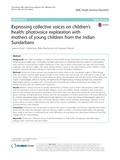| dc.contributor.author | Ghosh, Upasona | |
| dc.contributor.author | Bose, Shibaji | |
| dc.contributor.author | Bramhachari, Rittika | |
| dc.contributor.author | Mandal, Sabyasachi | |
| dc.date.accessioned | 2017-04-06T14:48:45Z | |
| dc.date.available | 2017-04-06T14:48:45Z | |
| dc.date.issued | 2016-11-15 | |
| dc.identifier.citation | Ghosh, U., Bose, S., Bramhachari, R. and Mandal, S. (2016) Expressing collective voices on children’s health: photovoice exploration with mothers of young children from the Indian Sundarbans. BMC Health Services Research, 16(7), p.119. | en |
| dc.identifier.issn | 1472-6963 | |
| dc.identifier.uri | https://opendocs.ids.ac.uk/opendocs/handle/20.500.12413/12937 | |
| dc.description.abstract | Background:
The Indian Sundarbans is marked by inhospitable terrain and frequent climatic shocks which jointly hinder access to health care. Community members, and women in particular, have few means to communicate their concerns to local decision makers. Photovoice is one way in which communities can raise their local health challenges with decision makers. This study unlocks mothers’ voices on the determinants of their children’s health to inform local level decision-making on child health issues in the Indian Sundarbans.
Methods:
Photovoice action research was conducted in three blocks in the Sundarbans region of West Bengal, India. The project involved eight groups of eight to ten mothers who had at least one child below 6 years of age across four villages. The mothers received training on photo documentation and ethical concerns before taking two rounds of photographs within 6 months, interspersed by fortnightly group meetings facilitated by researchers. Photographs and key messages were communicated to local decision makers during block and village level interface sessions with the mothers and researchers.
Results:
Mothers’ photos focused on specific determinants of health, such as water and sanitation; health status, such as malnutrition and non-communicable diseases; service accessibility; climate conditions; and social issues such as early marriage and recurrent pregnancy. Some issues were not captured by photos but were discussed in group meetings, including domestic violence and the non-availability of medical practitioners. We found differences by mother’s educational status, livelihood and caste identity in the extent and nature of photographs taken. As a result of the mother’s interface with community decision makers, which included showcasing a selection of their photos, efforts to improve road infrastructure and human resource availability in the primary health centres and local government were realized.
Conclusion:
Photovoice has the potential to express the voices of vulnerable communities regarding their health needs and can help them dialogue with local decision makers to inform community health policy and planning. More needs to be done to understand how social differences among photovoice participants influences how they engage with the methodology. | en |
| dc.language.iso | en | en |
| dc.publisher | BMC Health Services Research | en |
| dc.rights.uri | http://creativecommons.org/licenses/by/4.0/ | en |
| dc.subject | Children and Youth | en |
| dc.subject | Health | en |
| dc.title | Expressing Collective Voices on Children’s Health: Photovoice Exploration with Mothers of Young Children from the Indian Sundarbans | en |
| dc.type | Article | en |
| dc.identifier.externaluri | https://bmchealthservres.biomedcentral.com/articles/10.1186/s12913-016-1866-8 | en |
| dc.identifier.doi | 10.1186/s12913-016-1866-8 | |
| dcterms.dateAccepted | 2016-11-15 | |
| rioxxterms.funder | Default funder | en |
| rioxxterms.identifier.project | Default project | en |
| rioxxterms.version | VoR | en |
| rioxxterms.versionofrecord | 10.1186/s12913-016-1866-8 | en |
| rioxxterms.funder.project | c941507f-fd0b-4fc3-9822-4b2132f61a1d | en |


